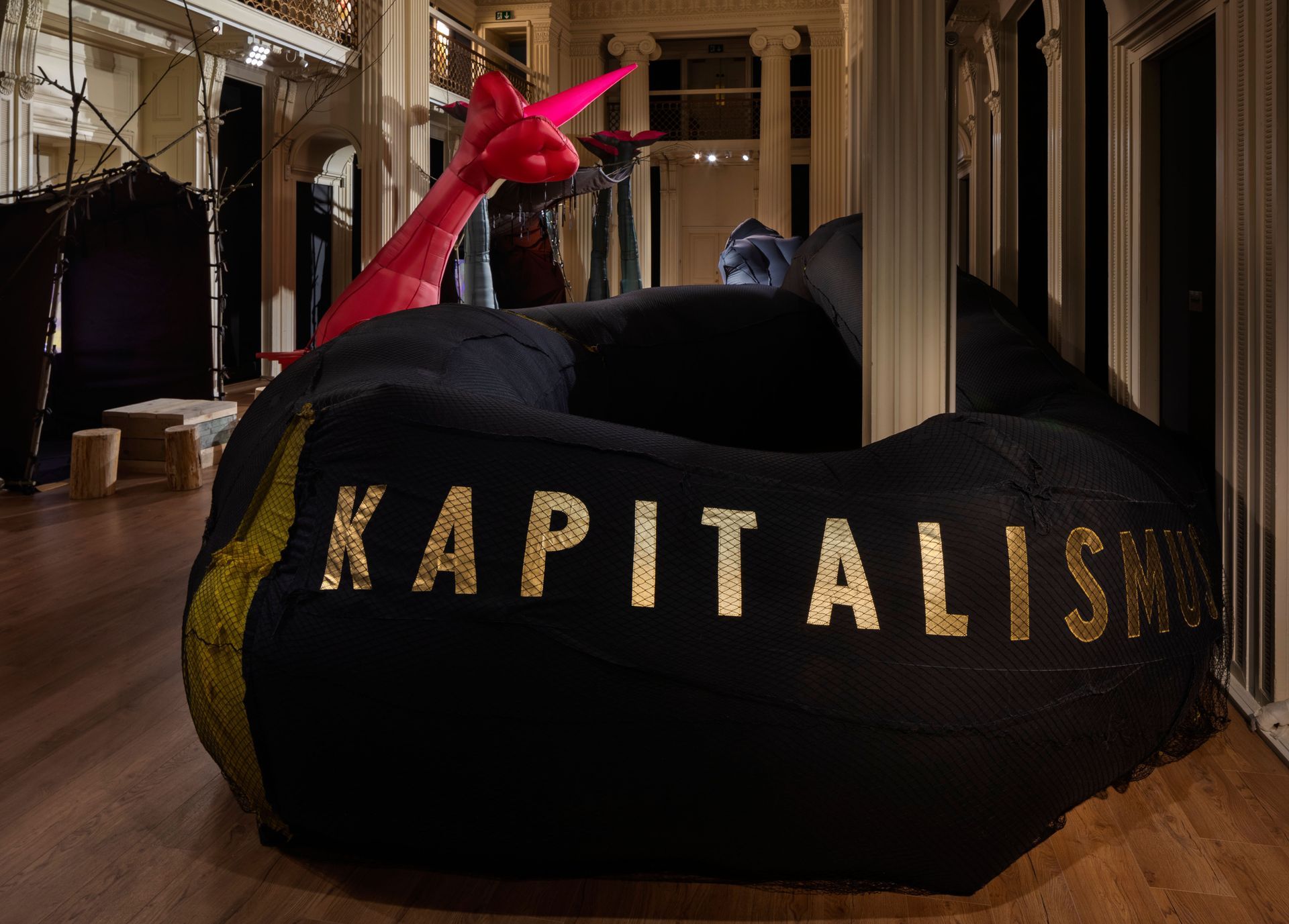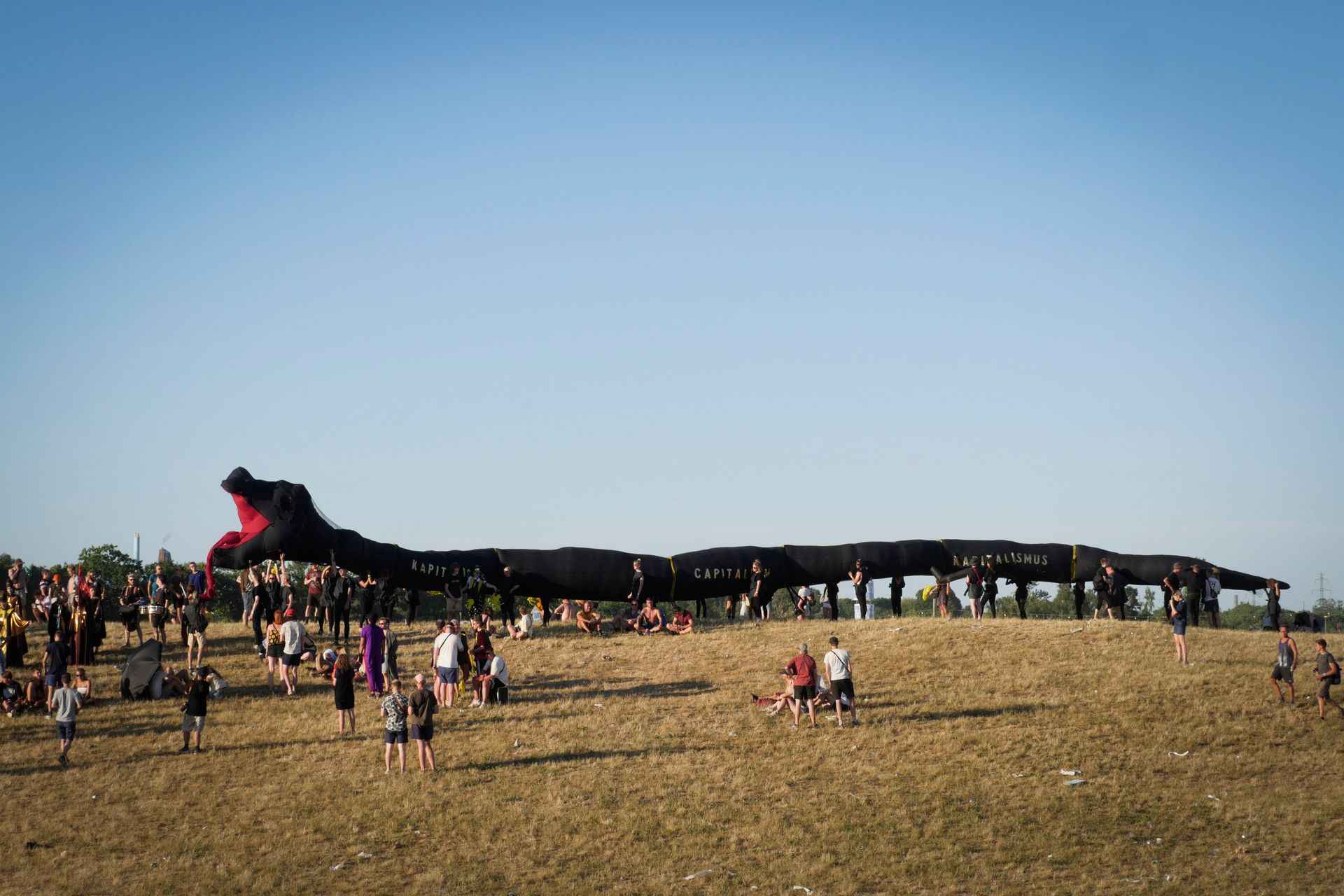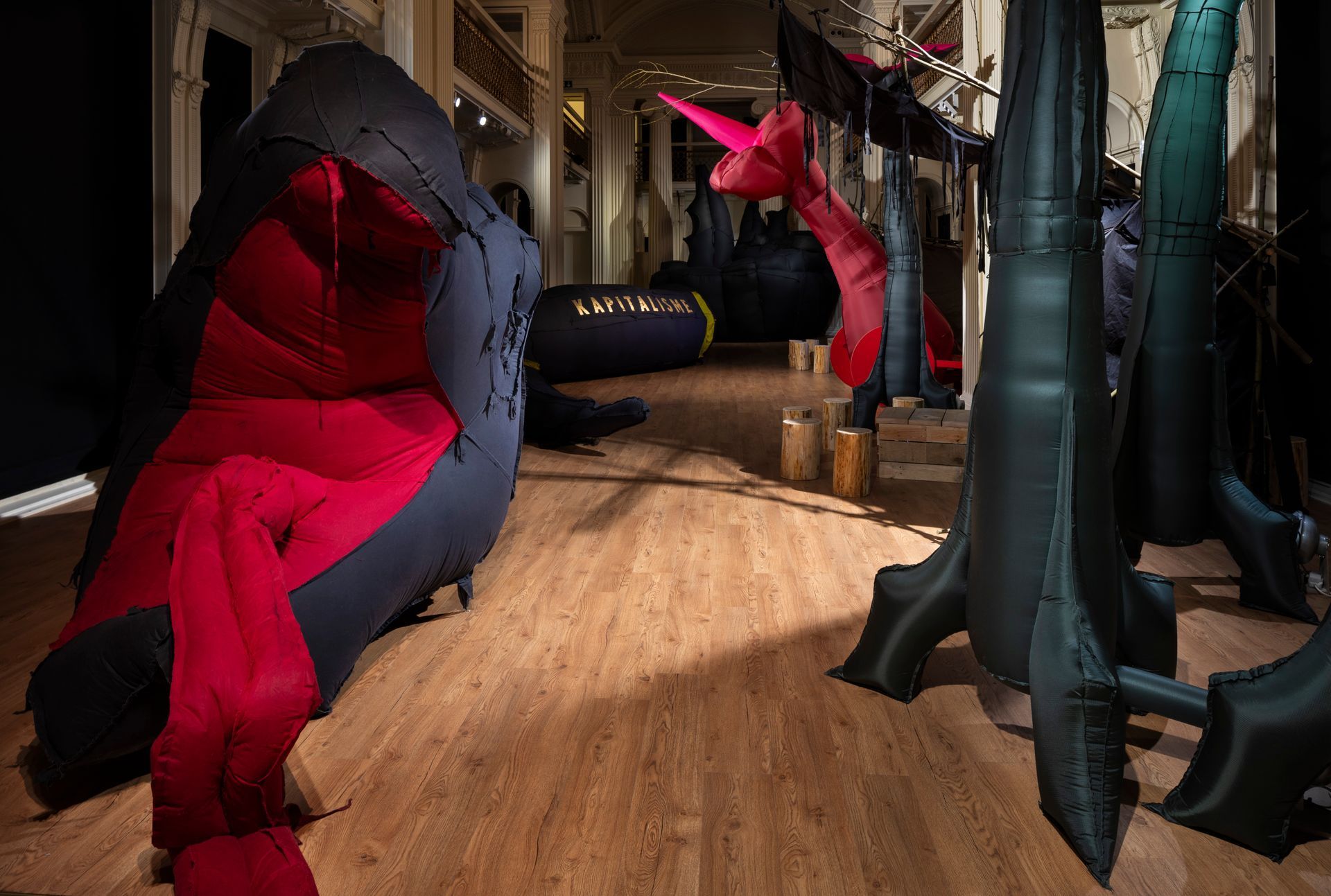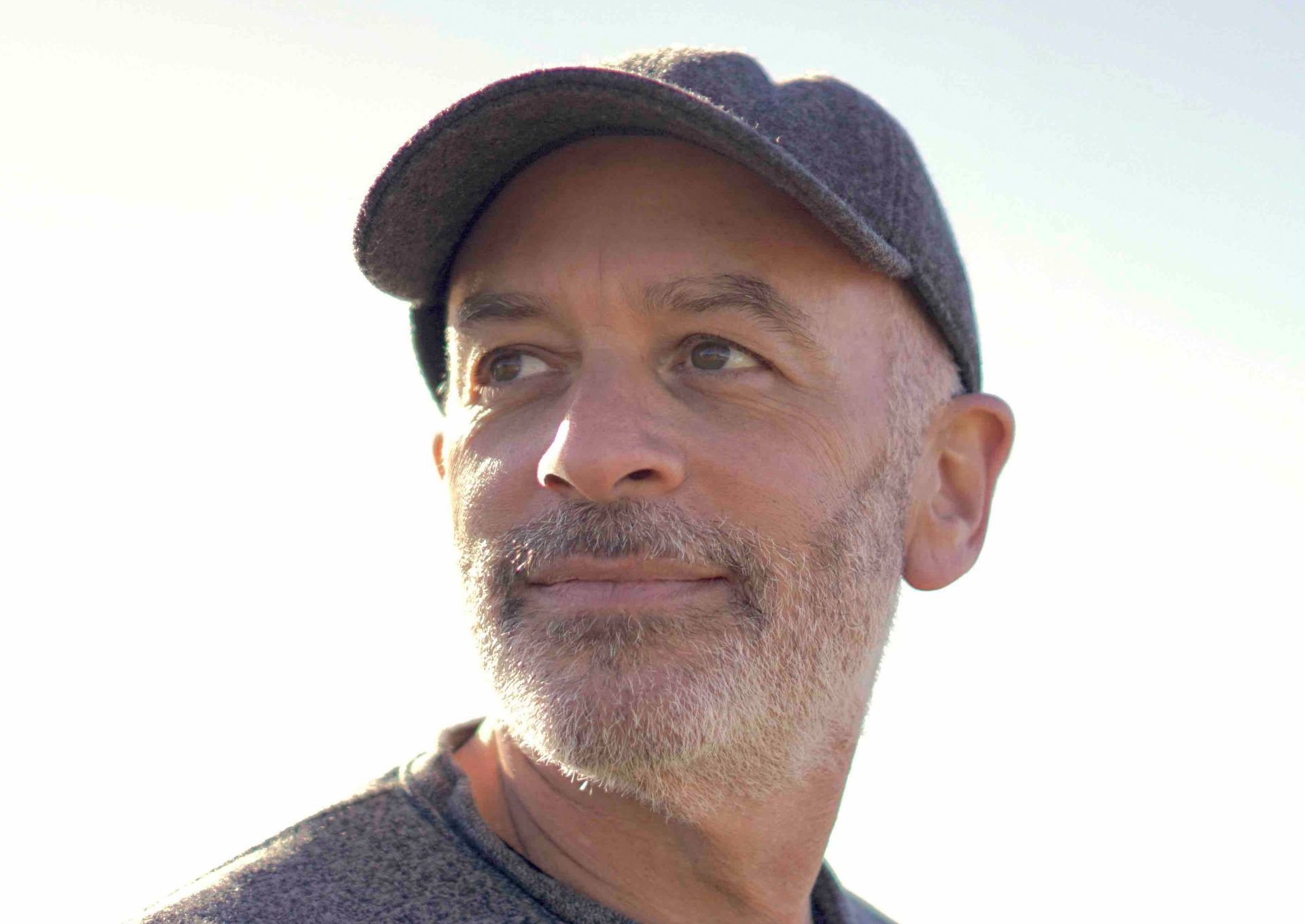
©Walker & Bromwich
Walker&Bromwich: “Hardly anyone in the UK knows about this important piece of labour history.“
The British artists Zoe Walker and Neil Bromwich have collaborated for over two decades, creating art that addresses societal and ecological issues. Their new exhibition, Searching for a Change of Consciousness, brings together works crafted to explore new ways of thinking and living. Their focus is to investigate the idea of a global shift in consciousness. A central work by the artists is Llechi A Llafur // Slate or State, which sheds light on the Great Penrhyn Strike (1900–1903) at the Penrhyn slate quarry in North Wales. This was the longest industrial dispute in British history. For Llechi A Llafur, they worked with former quarry workers, the Penrhyn Choir, and the local community in Bethesda to narrate the story of the strike and its generational trauma. The artists aim to make this largely forgotten history visible again, shaped by unjust working conditions, colonial exploitation, and the struggle for workers’ rights.
The artistic rise of sculptor Walker and Bromwich, originally rooted in painting, began in 2002 with their project Celestial Radio, a mobile radio station on the Essex coast. Their works, often participatory and site-specific, combine performance, sculpture, and film to address themes such as the climate crisis, colonialism, and social justice. Their creations seek to provoke reflection on the interconnections of capitalism, colonialism, and environmental destruction – and on the possibility of living differently.
————-
12. June 2025
ART/ENVIRONMENT
Name: Zoe Walker, Artist
Occupation: Artist, founder Walker & Bromwich
Name: Neil Bromwich
Occupation: Artist, founder Walker & Bromwich

©Walker & Bromwich
AM: Your whole idea of a change of consciousness—how did that come about?
Neil Bromwich: Many of the works in the exhibition deal with how we can live differently in the world and how we can address specific social and environmental issues. We decided to bring them together under the title Searching for a Change of Consciousness. How can we change people’s awareness so that they think differently about their lives in the world, alter their psyche? Obviously, most of the damage in the world is caused by humans. So, if we can’t change the way we live and think, it will be difficult to do anything about the climate crisis or other problems.
“We created a kind of post-apocalyptic survival camp where people came together after an apocalyptic event to discuss how we could rebuild society and live in greater harmony with the planet.“
Zoe Walker: The title was inspired by the end of the Maya Long Count Calendar—2012 marked the end of this calendar, which spanned over 2,000 years. At the time, we were on a residency in a hippie commune in South Wales, and there was a lot of talk about what the end of the Maya Calendar might mean or trigger. Some saw it as a kind of apocalyptic end of the world, while others spoke of a change in consciousness, a new way of consciously perceiving the world we live in. In 2012, we got the opportunity to do an exhibition at the Baltic Centre for Contemporary Art, a major gallery in Northern England. We created a kind of post-apocalyptic survival camp where people came together after an apocalyptic event to discuss how we could rebuild society and live in greater harmony with the planet. Parts of Encampment of Eternal Hope are being shown in this exhibition.
“Hardly anyone in the UK knows about this important piece of labour history, so we wanted to bring it back into the public eye. Many workers’ stories are buried or go unacknowledged.“
AM: Can you describe what is in the exhibition and share some reactions from your audience?
Zoe Walker: We’re showcasing a range of works, including Llechi A Llafur // Slate or State, which means “Llechi A Llafur” in Welsh. It was created at the site of the longest strike in British industrial history, The Great Strike of Penrhyn slate quarry, Bethesda, North Wales, from 1900 to 1903. The project was commissioned by the National Trust and Trust New Art. Hardly anyone in the UK knows about this important piece of labour history, so we wanted to bring it back into the public eye. Many workers’ stories are buried or go unacknowledged.
“The castle was bought with money that Lord Penrhyn received as compensation for owning slave colonies in the Caribbean, in Jamaica, on a sugar plantation.“
Neil Bromwich: We worked with former quarry workers, with the Penrhyn Choir, and recreated part of the quarry, which they then carried into the castle. Many people were deeply moved by this film, and we received messages from people saying they cried while watching it.
The castle was bought with money that Lord Penrhyn received as compensation for owning slave colonies in the Caribbean, in Jamaica, on a sugar plantation. Like all slave owners, he was compensated when the slave trade was abolished. He invested this money in large areas of North Wales and monopolized slate production in Wales. Most people who previously owned or worked in small independent slate quarries were forced to work for Lord Penrhyn. These people suffered under unfair working conditions. Some were allocated good parts of the quarry, others poorer ones, and you were only paid for the amount of slate you produced per week. So they began to organize and unionize, which Lord Penrhyn didn’t like, and he locked them out.
There were newspaper reports about great hardship and hunger among the population because there was no social security back then. Families of six had to survive on half a loaf of bread for three or four days. Those who went back were condemned as “strikebreakers,” bradwr (“traitor”) and the trauma and suffering that took place from 1900 to 1903 were passed down through generations. We interviewed people who went to school in the 1960s and 1970s as children, and they said that when you started school, you were first asked which family you came from. If you came from a family that broke the strike, you stood on one side of the playground, and if you came from a family that held out during the strike, you stood on the other. So we wanted to provide an opportunity to tell this story in Penrhyn Castle, the workers’ stories of the people who worked in the slate quarry and were part of the Great Penrhyn Strike. This was a very significant step in the labor movement in Britain that helped establish workers’ rights.

©Walker & Bromwich

©Walker & Bromwich
Zoe Walker: When you enter the exhibition, you’ll find the Serpent of Capitalism, next to the Love Cannon, which belongs to the Encampment of Eternal Hope, as well as the work Slate or State.
“The volcanic rock standing in resistance to extractivist technique in the way that the quarry men and families had stood in resistance thought the strike.“
Neil Bromwich: The form of Llechi A Llafur // Slate or State, features a piece of volcanic rock, like a kind of turret, that couldn’t be quarried by the workers. We found some etchings in the archive at Penrhyn Castle they showed a very distinctive part of Penrhyn quarry that has a volcanic rock which could not be extracted like the slate and stands like a turret. It’s very recognisable to locally. We decided on the form of the sculpture Slate or State from seeing this etching as we wanted to make something that was both uncanny but recognisable as a symbol of the quarry. The volcanic rock standing in resistance to extractivist technique in the way that the quarry men and families had stood in resistance thought the strike.
Zoe Walker: The slate sculpture, Slate or State, was installed in Penrhyn Castle. In the photo from Bethesda, you see the historic slate quarry in the background. Young people from the community carry our quarry on their shoulders. The film begins with the older generation, some of whom worked in the slate quarry and are also members of a Welsh male choir.
Another photo shows a music teacher together with the poet Trimble, who sings the demands of the strike: a demand for community, a demand for power, a demand for fair pay. “We demand power.” That’s sort of a poet’s interpretation of some of the strike demands. Then we marched to the castle, led by the choir, singing in Welsh, demanding the fulfillment of these demands. We were let into the castle, and we blew up the quarry there, and the choir sang. It was a very powerful and emotional moment.
Neil Bromwich: Within Searching for a Change of Consciousness, the Slate or State project is closely related to another project called Encampment of Eternal Hope. This film includes many interviews with indigenous people, activists, and community members from South America. The relationship between these two films, these insights into working people from North Wales and people from indigenous communities in South America, is really interesting because it brings together this history of extractivism and these early colonial techniques that were tested in Britain, in Wales, and Scotland.
Zoe Walker: We have had a wide range of visitors to the exhibition including - Edinburgh Sustainable Africa Futures (WESAF) Doctoral Programme who commented that Slate or State – connected to their research in Ghana and South Africa. The work helped them to see the hierarchies of British society and how, in fact, the ruling classes coerce and exploit workers. It helped them see a commonality of struggle between working class communities in different parts of the world.
AM: And how are these projects organized? How do you get these people to participate? That’s huge.
“In Penrhyn Castle, for a long time, the narrative was about Lord Penrhyn, the great lord, and the achievements of the Penrhyn family. There was nothing about the history of the slave trade, the great strike, or the quarry.“
Zoe Walker: It’s quite challenging because they’re all different in their own way. The project in North Wales is easier to describe because we were commissioned by the National Trust to change the stories told in National Trust buildings. In Penrhyn Castle, for a long time, the narrative was about Lord Penrhyn, the great lord, and the achievements of the Penrhyn family. There was nothing about the history of the slave trade, the great strike, or the quarry. And because many people in that area haven’t moved away, this is within the generational memory, passed across just 4 to 5 generations, almost in living memory, because the families stayed there. That’s why people don’t go to the castle.
We first found a local artist, Rebecca Hardy-Griffith, she worked with us co-ordinating local engagement. She first organised a public meeting at the local puband organized a public meeting in the local pub. That generated a lot of interest. We worked at the community center, I went to lots of coffee mornings to meet people. We met Rhys Trimble, a brilliant poet and performer, who we worked with. And then we met the Penrhyn Choir, so we worked with them, they are amazing. We try to be a bit like detectives or journalists to bring people together.
Another artwork in the exhibition Serpent of Capitalism was inspired by a poster by the 19th Century Socialist Illustrator, Walter Crane. The image shows a snake encircling a globe with the word “Capitalism.” The snake is held in check by a heroic female figure standing on top of the globe, together with workers of the world. It’s this struggle between freedom and capitalism, this thing that strangles people, the workers. When Roskilde Music Festival commissioned us to make a work we visited Denmark and did some research, we met with the Danish anarchist theatre group Solvognen ("the Sun Chariot") from 1970s and 1980s who’s work we were very inspired by, and we discussed with them the idea of Serpent of Capitalism performance.
The serpent is at the centre of creation myths from across the world , in Norse Mythology there is the Midgard Serpent or World Serpent that circles the globe in Aboriginal culture in Australia there is the rainbow serpent in South American Indigenous cultures the double helix serpent is often part of their cosmovision. In the western world in many pre-Christian, pre-Jewish mythologies the serpent is both a destructive and creative force bringing the world into being and therefore being respected and worshiped. The idea with the Serpent of Capitalism is that the serpent of creation has been co-opted by the dominant belief system of Capitalism. At Roskilde music festival we perform a ritual where the serpent sheds its capitalist skin for a better world.
“Through the act of performing, a connection is created, rather than an educational idea of a monument and the permanence of things.“
Neil Bromwich: It’s not so important to us that things are permanent. Our practice is more tied to the idea of a temporary performance or ritualistic work that is connected to place. Through the act of performing, a connection is created, rather than an educational idea of a monument and the permanence of things. I think the mindset, the shift in consciousness that we might need to make in terms of the climate crisis and the way we live, is to be more temporary. The fact that we can’t rely on things being permanent and fixed.
Zoe Walker: Our work is about bringing people together. Projects like the Encampment of Eternal Hope create a festival-like space where people reflect on how we might live in a post-apocalyptic world. During COP26 in Glasgow, we worked with a Colombian art organization called Más Arte Más Acción. We decided to focus on amplifying the indigenous voice. Then we connected with Minga Indígena, a group of indigenous representatives from across South America.
Neil Bromwich: They had called a “Minga,” a gathering of the community for collective action. If they want to build a boat, for example, they call a Minga. And they had called a Minga for the climate crisis. The participants came from the high Andes in Peru to the Amazon in Brazil. They called it Abya Yala the Indigenous name for the Americas
Many of the indigenous leaders had been to other COPs, other climate conferences, and said they realized their voices wouldn’t be heard in the conference hall. But what they wanted to do was make connections with the people in Glasgow, the people in Scotland, to make their voice heard and connect with communities here. They thought that was a more powerful way to bring their concerns about the destruction of the rainforests, the issues with the climate crisis, to communities.
Amalia, from the Quechua people in Argentina, spoke about indigenous teachings, the way of being, about defending water, earth, and medicine. One of the challenges she raised was that we, as Western people, need to become indigenous ourselves. We need to awaken those cells, those memories of our connections to the planet, our connection that sees that we are not separate from other beings, plants, animals, rivers, the planet, Gaia. And we need ceremonies, we need songs, we need to hear ancestral voices to reconnect.
AM: How does your installation connect to this?
“He said that one western view of the Indigenous is to think of them as magical beings who can protect the planet, like guardians of the forest. But in fact, it’s our shared responsibility for all of us to be guardians of the planet.“
Neil Bromwich: The installation is composed of a number of tents and inflatable's that are hybrid part plant / part weapon - anti weapons. We were thinking of a kind of post-apocalyptic Garden of Eden. The red cannon actually shoots balloons, a rocket that turns into flowers or trees.
Within this space Amalia sang the song, Ximena Xixi, a song about a creation myth about a hummingbird. Obviously, the indigenous representatives from South America face the destruction of their rainforests for extractivist purposes, their homes are being destroyed, and people are being killed. They are truly on the front lines. Many of them are very active activists but also representatives at COP26, in the main debate hall of the climate conference. Hector Fabio Yucuna Perea head of the youth wing of the Opiac, the National Organization of Indigenous Peoples of the Colombian Amazon, spoke within the Encampment. He said that one western view of the Indigenous is to think of them as magical beings who can protect the planet, like guardians of the forest. But in fact, it’s our shared responsibility for all of us to be guardians of the planet. Hearing this directly from an Indigenous person living in the Amazon was a very powerful call to us all to join together in protecting the planet.
Zoe Walker: The film we made with the Encampent of Eternal Hope during Cop26, we took to Indonesia and showed it to students as a way of sharing this message and as an ask for us all. We performed a ritual performance called An Act of Love, which pays tribute to Mother Earth, humanity, and all beings in this time of increasing conflict and destruction.
AM: So, how did you two meet? And as artists, are you always in agreement, or how does that work?
Zoe Walker: I have a sculptural background. I met Neil at a party; he has a painting background but is much more community-based. Then we started filming together, and it merged into one thing.
“One of the very early works of our collaboration that was widely recognized was Celestial Radio, a work about a radio station that we broadcast from a yacht, a boat, covered with 60,000 mirror tiles.“
Neil Bromwich: There was a kind of evolution in our collaboration, me as a cameraman, filmmaker, Zoe performing in front of the camera with these inflatable sculptures that were often based in landscapes, in nature. It seemed like a natural evolution of our practice to involve larger groups in the performance and to use these sculptures, situations, performances to discuss broader issues that were important to these communities. One of the very early works of our collaboration that was widely recognized was Celestial Radio, a work about a radio station that we broadcast from a yacht, a boat, covered with 60,000 mirror tiles.
In 2002, we began collaborating with communities on the Essex coast, a fairly empty landscape with a very atmospheric space where a religious community lives. We explored hidden stories and visionary ideas around Bradwell on Sea on the Essex coast. Two miles away is Britain’s second nuclear power plant. And it’s also the place where a very famous British pirate radio station, Radio Caroline, broadcast. We had all these conversations with people about the space, religion, and also the scientific community that worked at the power plant, about nuclear fission, about the sun, about the way the world began, the Big Bang. All these conversations came together. We had recorded them all and didn’t know what to do with them. And then we heard the story about the radio station broadcasting from a boat, and we thought we could broadcast all these visionary and hidden stories back to the community from the boat.
We gave people headphones, radios, and a map and asked them to walk along the coast. And then we were asked to do it in different places in Scotland, but also Thessaloniki in Greece, in Newcastle in Northeast England, near the Isle of Skye in Scotland. It was actually also in Sydney. Sunken stories and current activities that are visionary in some way. A key for us was talking to other people, listening, and recording stories. I think that was the foundation of the work alongside the material sculpture.
AM: So that was your breakthrough as artists?
Zoe Walker: Before we collaborated, I had a solo exhibition in Edinburgh, which was kind of a breakthrough, I think, shortly after I did my master’s. Because we work with public audiences and public spaces, there are always two audiences: the art audience and the public audience. For the public, Celestial Radio was very significant. The Encampment exhibition at the Baltic in 2012 was also important.
AM: Do you have another global issue in mind that you’d like to address as artists?
Neil Bromwich: We’ve been working on a project about air and water pollution, a collaborative project with a young group of Indonesian artists, an art foundation called Rakasa. It’s called Under the Bridge, Water and Air, the project links together two local communities on other sides of the globe around climate justice.
---------

©Walker & Bromwich
TOP STORIES
DÜSSELDORF
Dr Bastian Fleermann: ‘From the first to the very last day in Düsseldorf, there was resistance from very courageous men and women, from very different directions.’
_____________
ENVIRONMENT
007: Who is Paul Watson and why was he arrested?
_____________
FREEDOM OF SPEACH
Julian Assange und die Pressefreiheit. Eine kleine Chronik (DE)
_____________
DÜSSELDORF OPERA
The surprising switch of course
_____________
PHOTOGRAPHY
Without censorship: World Press Photo publishes the regional winners of the 2024 photo competition
_____________
FLORENCE
_____________
April 2024
DÜSSELDORF
Controversy surrounding the Düsseldorf Photo Biennale
_____________
WAR
March 2024
_____________
ISRAEL
November 2023
_____________
ENGLISH CHRISTMAS
10 years of Glow Wild at Kew Wakehurst.
October 2023
_____________
TRIENNALE MILANO
Pierpaolo Piccioli explains his fascination with art.
_____________
NEW MUSEUMS
29 May 2023
_____________
NEW MUSEUMS
is coming in big steps.The Bernd and Hilla Becher Prize will be awarded for the first time.
19 May, 2023
_____________
VISIONS, ARCHITECTURE
MARCH 10, 2023
_____________
CHECK THE THINGS YOU WANT TO THROW AWAY
HA Schult's Trash People at the Circular Valley Forum in Wuppertal on 18 November 2022.
NOVEMBER 19, 2022
_____________
THE OPERA OF THE FUTURE
Düsseldorf, capital of North Rhine-Westphalia will receive the opera house of the future.
FEBRUARY 15, 2023
_____________
FLORENCE
The extraordinary museums of Florence in 2023.
JANUARY 1, 2023
_____________
DÜSSELDORF
DECEMBER 11, 2022
RELATED TALKS






